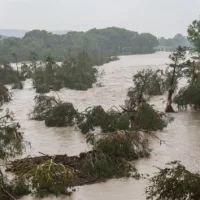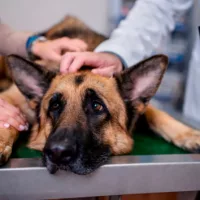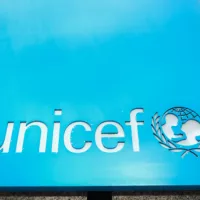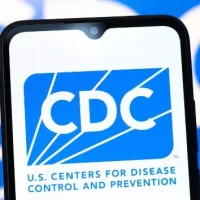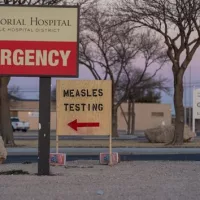
(ABC) Timothy Lewis is one of the 463 Native Americans across the country that volunteered in the Pfizer COVID-19 vaccine trial.By ALLIE YANG AND TENZIN SHAKYA, ABC NEWS
Navajo medicine man Timothy Lewis starts each day with a corn pollen seed offering to the creator. He prays for his family and the world’s wellbeing amid the ongoing coronavirus pandemic.
“I hope that we can get back to normal,” Lewis said. “I want to see my grandkids again. I wanna hold them and I wanna hug them again.”
Lewis is one of the 463 Native Americans across the country that volunteered in one of Pfizer’s COVID-19 vaccine trials; his was a pivotal Phase 3 trial. Both of his parents were also traditional Navajo healers, and he says they instilled in him a responsibility to help others whenever possible.
“My parents would have liked this,” Lewis said. “They would have wanted me to do this. And that’s the reason why I actually volunteered. I really want us to come back to being the way we were [before the pandemic].”
The virus has ravaged the Navajo Nation, which covers an area the size of West Virginia, and is home to more than 300,000 enrolled tribal members. Despite some of the strictest lockdowns and weeks-long curfews, the communities there are still in the throes of a lasting crisis.
Just this week, the Navajo Department of Health reported 272 new cases. As 75 communities continue to face uncontrolled transmission of COVID-19, there have been a reported 21,833 total cases throughout the Navajo Nation, with over 760 deaths since March.
Several factors have contributed to the virus’ proliferation in the Navajo Nation, including an abundance of multigenerational homes where people live with their extended families in small buildings.
There are also only 13 grocery stores throughout the 27,000-square-mile reservation, according to Dr. Loretta Christensen, chief medical officer of the Indian Health Service in the Navajo area.
“We’ve been working with John Hopkins Center for American Indians for quite some time here in Navajo,” she said. “What we found through multiple vaccine trials, there [are] often vaccines that are more appropriate for our population that we do respond better to, that we get better immunity from.”
Because of people like Lewis, the research on Pfizer’s COVID-19 vaccine included data on Native Americans’ reactions to the vaccine.
“They volunteered. So they’re trailblazers,” Navajo Nation President Jonathan Nez said. “Based on that data that’s available right now, it indicates that this vaccine doesn’t have the negative, adverse effect on Native Americans.”
Christensen is developing the Navajo Nation’s vaccine plan and is helping distribute and administer the shot to health care workers like EMS, medical practitioners and medicine men in the initial phase of the process.
The Navajo Nation received 3,900 Pfizer vaccine doses so far and nearly 8,000 from Moderna this week.
Dr. Michelle Tom, the only Navajo emergency physician at the Winslow Indian Health Care Center in Arizona, got her vaccine this week.
“It’s finally the day I had envisioned,” Tom told ABC News. “It couldn’t have come soon enough. It’s a huge deal for Navajo people, for Native people, [for] all the families it hit so hard.”
At the height of the crisis, Tom left her family and moved to an apartment an hour away to try to minimize the risk of exposing the group of people she’s trying to save.
ABC News spoke to Tom in May, when the Navajo Nation had the highest infection rate per capita in the country.
“My job is immensely hard because I have such a connection to my people and to my land — my ancestors and my grandparents,” she said at the time. “And to put me here today … Our elders are our teachers, protectors. They hold all the key elements that we need to have a strong sense of identity.”
Gwen Livingston, a Johns Hopkins American Indian Health research nurse, has been working with Pfizer and partner BioNTech on their COVID-19 vaccine trials in the Navajo Nation amid a second, deadlier wave.
“We’ve been trying, we’ve been educating, we’ve been doing what we can as far as social distancing, wearing our masks, sanitizing, doing what we can,” she said. “Then, our numbers are rising again. So yeah, something needs to happen. And this vaccine rolls out, and this is just another resource. This is just another tool. This is something that we need to combat this virus.”
For Livingston, the virus’ toll has been personal. She is from the Navajo Nation and the Khapo Owingeh, a Santa Clara pueblo in New Mexico.
In June, Livingston lost her grandfather to COVID-19 and had to watch her grandmother say goodbye alone, from a distance.
“Having to explain to her why she could not see him, why she could not be with him, why we were outside of the window and could not go inside the building to see him — that really hit home and it hit hard,” Livingston said.
“To hear the pain and the hurt just from talking with family members, or even with patients who have COVID-19,” she said. “Just the struggle to breathe alone, and the questions of, ‘What’s gonna happen to me?’ And there’s that fear of, ‘Am I gonna die?’”
The virus has brought to light the generational health problems that have afflicted the Navajo people.
“We got high rates of diabetes, cardiovascular disease, cancer,” Nez said. “And as the nation saw during the first wave in April, the Navajo Nation got hit hard.”
Livingston says that even if someone with high blood pressure and diabetes has asymptomatic COVID-19, “the damage is already happening.” It’s high blood pressure and diabetes that could cause them to need dialysis.
“By the time they reach stage four [of chronic kidney disease], they’re already having to think about their treatment options when it comes to dialysis,” she explained. “That is the end result of these chronic illnesses… Sometimes that reality, it’s too late in some cases.”
Despite indigenous peoples’ participation in vaccine trials, there’s still a deep mistrust in the community.
Prior to the European conquest, Native Americans had never experienced smallpox, measles or the flu. Exposure to the “New World” diseases killed nearly 90% of their population.
In the 1860s, the Bureau of Indian Affairs implemented a series of boarding schools on Indian reservations, which separated children from their families.
“It was the whole idea of assimilating Indians into the white culture,” Livingston said. “It was the whole idea of, ‘Kill the Indian, save the man.’ And bringing these children, taking them from their homes, taking them from their families, taking them from everything that they know [and] putting them in schools — that was traumatic, too. They were punished for speaking their language, [or] anything to do with their culture.”
That intergenerational trauma is compounded by a history of forced experimentation on Native Americans.
“In the 1970s, the sterilization of Native American women was a huge traumatic event,” Livingston said. “[That] made it very, very hard for indigenous people to trust the federal government, or to even trust [the] Indian Health Service.”
Most tribal members say they are not against research, but that they want it done ethically and with consent from participants and community members.
In 2002, the Navajo Nation banned genetic research on its territory in order to prevent unethical medical experiments on Native Americans. In 2003, the Havasupai Indian tribe sued Arizona State University for sharing blood samples from a 1990s diabetes research project with researchers working on other projects without consent from the study participants. The tribe won the case in 2010.
Because of this long history, Lewis said he was met with skepticism when he told his friends and relatives about volunteering for the vaccine trial.
“They were saying, ‘Don’t do it.’ But I didn’t listen because I wanted to help,” he said. “I wanted to help my people.”
Christensen says she believes that COVID-19 vaccine makers need to be transparent and share the data they collect in order to build trust within the Navajo community.
“We really need [the] population of the Native Americans to be represented in data and how they respond to the vaccines,” Livingston said. “We really need to take a look at that so that we are better prepared to present this data to the community, and that way they would feel more comfortable in receiving the vaccine when the time comes.”
Acknowledging the trauma inflicted on the community is only half the battle. Livingston says traditional healers and Western health care providers should come together to help Native communities through the pandemic.
“[We should] work together in understanding medication, treatment — all of these things — in order to keep our people healthy,” she said.
“Lewis recognizes the benefit he has in having access to both Western medicine and the traditional medicine of his culture. “I have two worlds,” he said. “I’m lucky.”
Nez said he’s optimistic the Navajo community will get through this as they have survived many diseases, including the hantavirus outbreak in 1993.
“We are resilient,” he said. “Remember, our ancestors got us to this point… Now it is our turn to fight hard against this virus and to think about our children and our grandchildren.”
Copyright © 2020, ABC Audio. All rights reserved.
“I hope that we can get back to normal,” Lewis said. “I want to see my grandkids again. I wanna hold them and I wanna hug them again.”
Lewis is one of the 463 Native Americans across the country that volunteered in one of Pfizer’s COVID-19 vaccine trials; his was a pivotal Phase 3 trial. Both of his parents were also traditional Navajo healers, and he says they instilled in him a responsibility to help others whenever possible.
“My parents would have liked this,” Lewis said. “They would have wanted me to do this. And that’s the reason why I actually volunteered. I really want us to come back to being the way we were [before the pandemic].”
PHOTO: Timothy Lewis is one of the 463 Native Americans across the country that volunteered in the Pfizer COVID-19 vaccine trial.
ABC
ABC
Timothy Lewis is one of the 463 Native Americans across the country that volunteered in the Pfiz…Read More
The virus has ravaged the Navajo Nation, which covers an area the size of West Virginia, and is home to more than 300,000 enrolled tribal members. Despite some of the strictest lockdowns and weeks-long curfews, the communities there are still in the throes of a lasting crisis.
Just this week, the Navajo Department of Health reported 272 new cases. As 75 communities continue to face uncontrolled transmission of COVID-19, there have been a reported 21,833 total cases throughout the Navajo Nation, with over 760 deaths since March.
Several factors have contributed to the virus’ proliferation in the Navajo Nation, including an abundance of multigenerational homes where people live with their extended families in small buildings.
There are also only 13 grocery stores throughout the 27,000-square-mile reservation, according to Dr. Loretta Christensen, chief medical officer of the Indian Health Service in the Navajo area.
PHOTO: Dr. Loretta Christensen is the chief medical officer at Indian Health Services in the Navajo area.
ABC
ABC
Dr. Loretta Christensen is the chief medical officer at Indian Health Services in the Navajo area.
“We’ve been working with John Hopkins Center for American Indians for quite some time here in Navajo,” she said. “What we found through multiple vaccine trials, there [are] often vaccines that are more appropriate for our population that we do respond better to, that we get better immunity from.”
MORE: Navajo Nation hospitals at ‘breaking point’
Because of people like Lewis, the research on Pfizer’s COVID-19 vaccine included data on Native Americans’ reactions to the vaccine.
“They volunteered. So they’re trailblazers,” Navajo Nation President Jonathan Nez said. “Based on that data that’s available right now, it indicates that this vaccine doesn’t have the negative, adverse effect on Native Americans.”
Christensen is developing the Navajo Nation’s vaccine plan and is helping distribute and administer the shot to health care workers like EMS, medical practitioners and medicine men in the initial phase of the process.
PHOTO: Navajo Nation President Jonathan Nez
ABC
ABC
Navajo Nation President Jonathan Nez
The Navajo Nation received 3,900 Pfizer vaccine doses so far and nearly 8,000 from Moderna this week.
Dr. Michelle Tom, the only Navajo emergency physician at the Winslow Indian Health Care Center in Arizona, got her vaccine this week.
“It’s finally the day I had envisioned,” Tom told ABC News. “It couldn’t have come soon enough. It’s a huge deal for Navajo people, for Native people, [for] all the families it hit so hard.”
PHOTO: Dr. Michelle Tom, the only Navajo emergency physician at the Winslow Indian Health Care Center in Arizona, got her vaccine this week.
Michelle Tom
Michelle Tom
Dr. Michelle Tom, the only Navajo emergency physician at the Winslow Indian Health Care Cent…Read More
At the height of the crisis, Tom left her family and moved to an apartment an hour away to try to minimize the risk of exposing the group of people she’s trying to save.
ABC News spoke to Tom in May, when the Navajo Nation had the highest infection rate per capita in the country.
PHOTO: Dr. Michelle Tom, the only Navajo emergency physician at the Winslow Indian Health Care Center in Arizona, got her vaccine this week.
Michelle Tom
Michelle Tom
Dr. Michelle Tom, the only Navajo emergency physician at the Winslow Indian Health Care Cent…Read More
“My job is immensely hard because I have such a connection to my people and to my land — my ancestors and my grandparents,” she said at the time. “And to put me here today … Our elders are our teachers, protectors. They hold all the key elements that we need to have a strong sense of identity.”
Gwen Livingston, a Johns Hopkins American Indian Health research nurse, has been working with Pfizer and partner BioNTech on their COVID-19 vaccine trials in the Navajo Nation amid a second, deadlier wave.
“We’ve been trying, we’ve been educating, we’ve been doing what we can as far as social distancing, wearing our masks, sanitizing, doing what we can,” she said. “Then, our numbers are rising again. So yeah, something needs to happen. And this vaccine rolls out, and this is just another resource. This is just another tool. This is something that we need to combat this virus.”
For Livingston, the virus’ toll has been personal. She is from the Navajo Nation and the Khapo Owingeh, a Santa Clara pueblo in New Mexico.
MORE: How one young activist is standing up for her Navajo community’s COVID-19 relief
In June, Livingston lost her grandfather to COVID-19 and had to watch her grandmother say goodbye alone, from a distance.
“Having to explain to her why she could not see him, why she could not be with him, why we were outside of the window and could not go inside the building to see him — that really hit home and it hit hard,” Livingston said.
“To hear the pain and the hurt just from talking with family members, or even with patients who have COVID-19,” she said. “Just the struggle to breathe alone, and the questions of, ‘What’s gonna happen to me?’ And there’s that fear of, ‘Am I gonna die?’”
The virus has brought to light the generational health problems that have afflicted the Navajo people.
“We got high rates of diabetes, cardiovascular disease, cancer,” Nez said. “And as the nation saw during the first wave in April, the Navajo Nation got hit hard.”
Livingston says that even if someone with high blood pressure and diabetes has asymptomatic COVID-19, “the damage is already happening.” It’s high blood pressure and diabetes that could cause them to need dialysis.
PHOTO: Gwen Livingston, a Johns Hopkins American Indian health research nurse, has been working with Pfizer-BioNTech COVID-19 on vaccine trials in the Navajo Nation amid a second, more deadly wave.
ABC
ABC
Gwen Livingston, a Johns Hopkins American Indian health research nurse, has been working with…Read More
“By the time they reach stage four [of chronic kidney disease], they’re already having to think about their treatment options when it comes to dialysis,” she explained. “That is the end result of these chronic illnesses… Sometimes that reality, it’s too late in some cases.”
Despite indigenous peoples’ participation in vaccine trials, there’s still a deep mistrust in the community.
Prior to the European conquest, Native Americans had never experienced smallpox, measles or the flu. Exposure to the “New World” diseases killed nearly 90% of their population.
In the 1860s, the Bureau of Indian Affairs implemented a series of boarding schools on Indian reservations, which separated children from their families.
“It was the whole idea of assimilating Indians into the white culture,” Livingston said. “It was the whole idea of, ‘Kill the Indian, save the man.’ And bringing these children, taking them from their homes, taking them from their families, taking them from everything that they know [and] putting them in schools — that was traumatic, too. They were punished for speaking their language, [or] anything to do with their culture.”
That intergenerational trauma is compounded by a history of forced experimentation on Native Americans.
“In the 1970s, the sterilization of Native American women was a huge traumatic event,” Livingston said. “[That] made it very, very hard for indigenous people to trust the federal government, or to even trust [the] Indian Health Service.”
Most tribal members say they are not against research, but that they want it done ethically and with consent from participants and community members.
In 2002, the Navajo Nation banned genetic research on its territory in order to prevent unethical medical experiments on Native Americans. In 2003, the Havasupai Indian tribe sued Arizona State University for sharing blood samples from a 1990s diabetes research project with researchers working on other projects without consent from the study participants. The tribe won the case in 2010.
Because of this long history, Lewis said he was met with skepticism when he told his friends and relatives about volunteering for the vaccine trial.
MORE: Navajo Nation, reeling from coronavirus, focuses attention on elections
“They were saying, ‘Don’t do it.’ But I didn’t listen because I wanted to help,” he said. “I wanted to help my people.”
Christensen says she believes that COVID-19 vaccine makers need to be transparent and share the data they collect in order to build trust within the Navajo community.
“We really need [the] population of the Native Americans to be represented in data and how they respond to the vaccines,” Livingston said. “We really need to take a look at that so that we are better prepared to present this data to the community, and that way they would feel more comfortable in receiving the vaccine when the time comes.”
Acknowledging the trauma inflicted on the community is only half the battle. Livingston says traditional healers and Western health care providers should come together to help Native communities through the pandemic.
“[We should] work together in understanding medication, treatment — all of these things — in order to keep our people healthy,” she said.
“Lewis recognizes the benefit he has in having access to both Western medicine and the traditional medicine of his culture. “I have two worlds,” he said. “I’m lucky.”
Nez said he’s optimistic the Navajo community will get through this as they have survived many diseases, including the hantavirus outbreak in 1993.
“We are resilient,” he said. “Remember, our ancestors got us to this point… Now it is our turn to fight hard against this virus and to think about our children and our grandchildren.”






